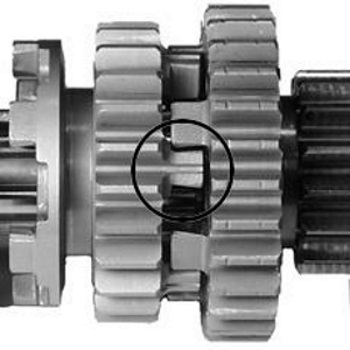
Imagine hitting a jump out of a corner and suddenly losing all power at the face. But the engine still sounds cranked at full rev.
A seasoned rider probably knows what happened but someone new or who has never encountered this likely has no idea what's in store upon landing. It's similar to bracing for a blind fall only to realize the distance was nowhere as expected. You're body braces for a 10 foot impact only to hit two feet later. Some manage unscathed while others, well, not so lucky.
You've now experienced the transmission in your dirt bike or ATV falling out of gear. It's called a false neutral and occurs most commonly from a bent or broken shift fork or shift shaft/shift drum issues but other transmission related issues cause gears to fall out or get stuck in gear, as well.
It's a hassle for sure and quickly ends your riding day.
Before the big drop happens you might notice a popping feeling or your chain slipping - most often under heavy load. That's the gears slipping in and out of neutral and probably from a worn or damaged shift fork that over time rounded off the transmission dog ears. (See photo)
Example of transmission dog circled
Like so many other mechanical related issues time is not your best friend. Eventually, the transmission on your dirt bike or ATV runs its course, requiring a replacement. The bottom line: Parts wear out.
Unfortunately, it's not as simple as replacing the clutch pack. Extensive transmission work is the only cure and the repair is a multi-day job that includes a complete teardown of the motor. If you're not up for it, a visit to a trusted mechanic is in your future. Or you could just trade your bike in for a new one. We know someone who did that.
Worn shift fork from a Yamaha Raptor 700
No, you cannot replace the transmission alone. It requires finesse and a lot of skill thus we won't discuss "How to Repair Your Dirt Bike or ATV Transmission." Instead we'll briefly explain the complexities and let you decide.
You'll need to remove:
- Cylinder
- Head
- Crank
- Piston
- Clutch
- Stator
- Flywheel
You'll likely need to replace:
- At least two gears
- Shift fork
- Complete gasket set for engine
- Clips or snap rings from input or output shaft
Tools you'll need:
- Crank case splitter
- Snap ring plyer set
- Flywheel puller
- Clutch hub holder
- Sockets sized 8mm to 24mm
- Torque wrench
- Crank case sealer
Once inside you need to check all parts to spec and determine what's worn, bent or mutilated. Transmission replacement parts likely extend beyond those mentioned above, get sold individually and as OEM. (Some aftermarket ATV transmission parts exist.) Removed clip or snap rings require replacing regardless of wear. The stator and flywheel need removing because you'll need to split the crank cases. Most reliable mechanics complete a top end while inside, as well.
Sound good? Didn't think so. If it does, then you better open a shop, if not already, because riders eventually need you.
Of course you can delay this inevitable course by proper maintenance. Don't neglect oil changes! Also, aggressive riding, dumping the clutch and heavy loads contribute to faster wear but if you're racing sometimes you've got to do what you've got to do. Most transmissions last between five and seven years so if it's in that window or you're feeling the slippage or other transmission related issues get a jump on a replacement before a jump ends your day.










